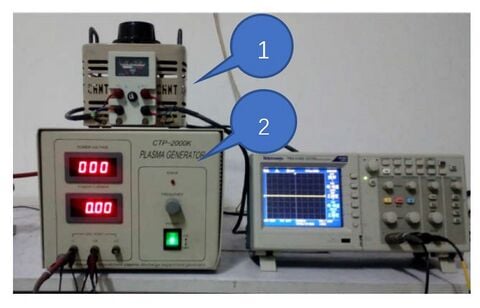The Plasma Discharge System consists of a voltage regulator, a plasma generator unit, and a reactor. It is typically employed for conducting arc discharge, dielectric barrier discharge, and glow discharge tests in various atmospheres such as air, oxygen, nitrogen, and other inert gases.
The objective of this project is to build a power supply for the experimental plasma discharge setup. The application-specific solar power supply includes an MPPT (Maximum Power Point Tracker) and an inverter specifically designed for this application. These components will be integrated into a single compact, cost-effective, and open-source package.
Description plasma discharge experimental setup[edit | edit source]
Plasma discharge system setup

Product composition
1. CTP 2000K Plasma power supply.
Product name: Low temperature plasma experimental power supplyModel: CTP 2000KOutput voltage(kV): 0-30Frequency(kHz): 5-20Power(W): 0-500
2. TDGC2-1 Contact Voltage Regulator (Resistive).
Rated input voltage: 220vRated capacity: 1kVAFrequency: 50HzOutput voltage range: (0-250) VRated output current: 4AWeight: 6.5kg
3. DBD Reactor.
Proposed power supply unit[edit | edit source]

Literature review on "Open source solar power supply unit for plasma generator"[edit | edit source]
1. Portable autonomous solar power plant for individual use
